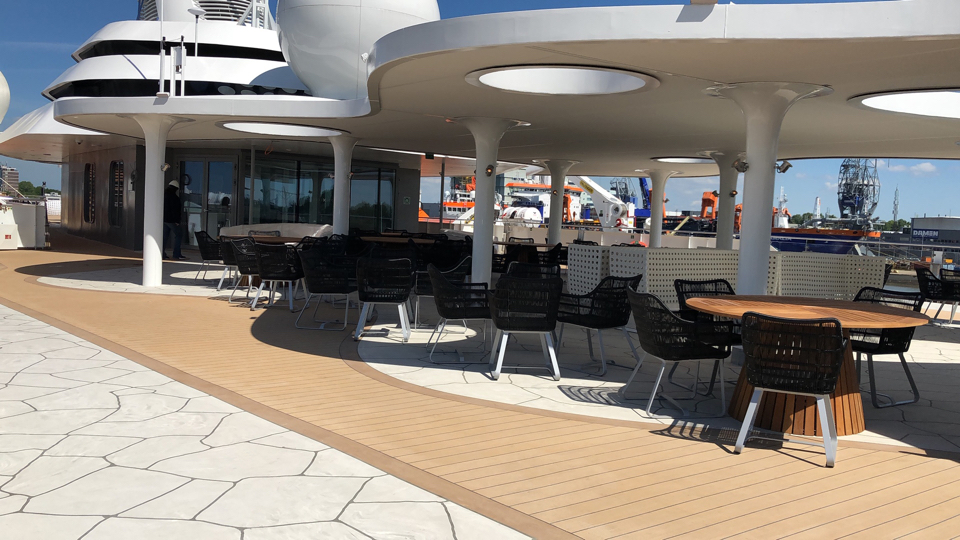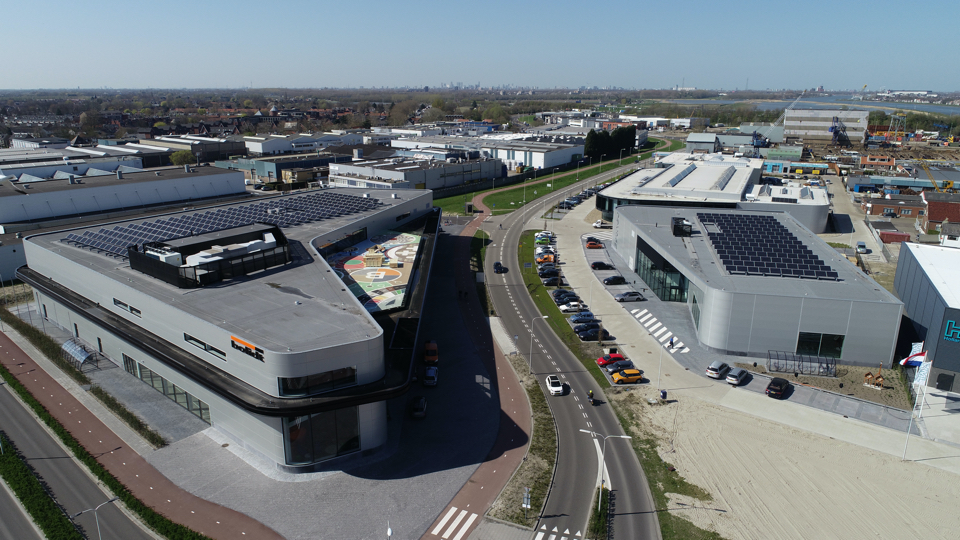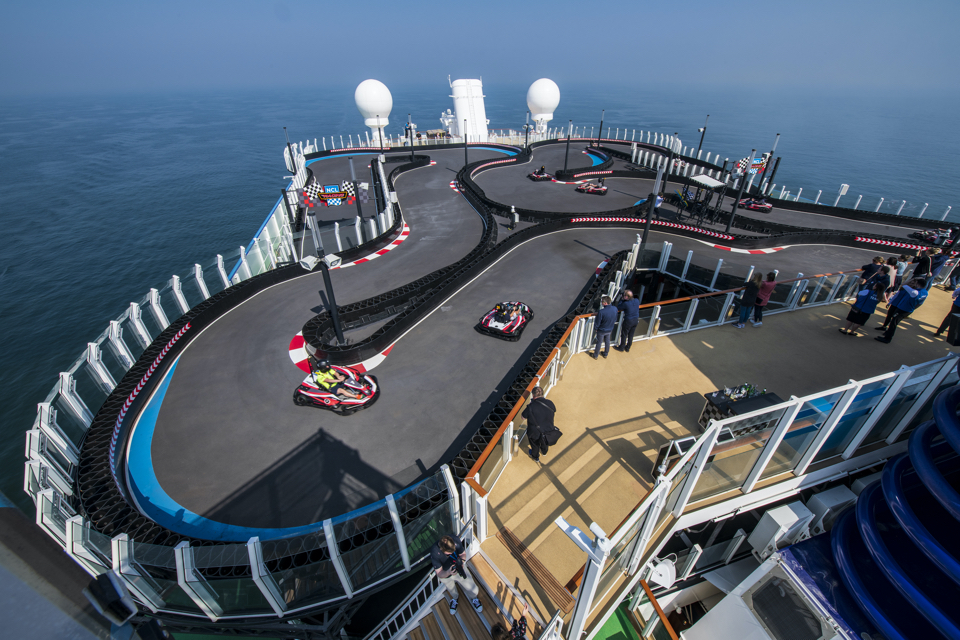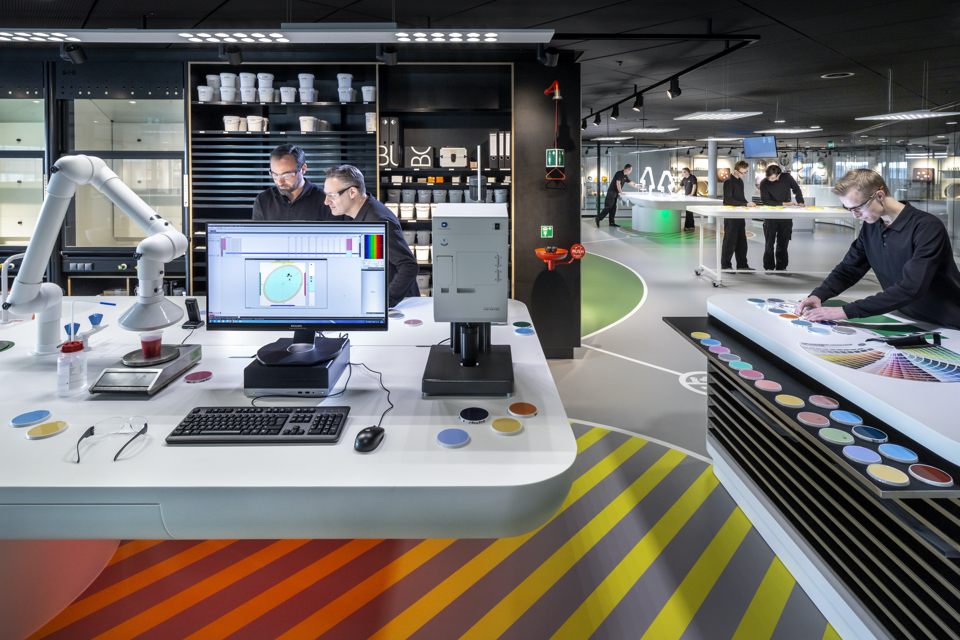The Dutch shipbuilding industry has but a small role to play in the construction and exploitation of cruise ships. Yet, with a market share of over fifty per cent, the parts that look like wood on board these ships, may well come from Dutch synthetics manufacturer Bolidt.
Since first customer in the cruise industry Holland America Line in the 1980s started to replace its teak decks, Bolidt has provided similar services to some 400 newbuilds and about as many refits. That’s a lot considering that there are approximately 300 cruise ships in operation at the moment, depending on where you draw the line in terms of size.
Maritime market most important
Although today the maritime market is the most important for Bolidt with a seventy per cent share in the turnover, the company only started in February 1964 by developing synthetic products for protecting and conserving steel and concrete objects. With concrete floors for all kinds of purposes in need of covers, Bolidt became an important player in floorings for the industry, public buildings, hospitals, sports facilities, rail, infrastructure, food factories, prisons and maritime industry.
Memorable projects include supplying the floor for the European Parliament several years ago and for the King Abdul Aziz Centre for World Culture in Saudi-Arabia in 2017. Making floors for buildings keeps on being important with a great variety of customers. Think of the Mathematics Gallery of the Science Museum in London, or the Danone Factory in Haps, the Netherlands (walls, ceilings and floors), and the replacement of the asphalt with a Bolidt wearing course on the Rheinsbrücke near Karlsruhe.
Text continues below picture

Bolidt designed and produced the floorings for expedition cruise ship Celebrity Flora.
Severely tested
The products of Bolidt are made from composite. They are made to comply with the specific demands of the customer in every field of activity where safety, sustainability, design, hygiene and easy maintenance is important – and where isn’t it? Chemistry is our DNA, they say at Bolidt. To find the right composition for a specific purpose, the company cooperates with different knowledge institutes.
Bolidt-products can cover round steel forms (railings), they are much lighter than wood (minus forty to fifty per cent), need less maintenance and are easy to combine with lighting or sensors.
The breakthrough in shipping came in the eighties and nineties after the IMO tightened the SOLAS-regulations for protection against fires on ships, especially ro-ro passenger and cruise vessels. Instead of using wood in decks, ship owners turned to less flammable alternatives.
From Miami, Bolidt serves the refit market, but the company also has an office in China that focuses on the Asian cruise market. For newbuilds, Bolidt works together with all major shipyards specialised in the construction of cruise ships such as the Meyer Werft in Papenburg, Turku in Finland, Chantiers de l’Atlantique in French Saint-Nazaire, Fincantieri in Italy and as of recently MV Werften in Wismar, Rostock and Stralsund.
Other ship types
Besides newbuilds, refits have become ever more important. In 2018, Bolidt was involved in 26 refit projects. Teams of specialist workers that install the decking can be sent to practically any yard, anywhere in the world.
Besides cruise ships, Bolidt floorings are increasingly found on other types of ships as well, such as fishing boats where the catch is already being processed on board and for which special floors and walls are needed to ensure high standards in handling, durability, hygiene and safety. Other examples include LNG carriers and offshore platforms where safety is enormously important and livestock carriers that have to be cleaned easily.
Bolidt floorings are increasingly found on other types of ships, such as fishing boats, LNG carriers and offshore platforms
Furthermore, even though for an owner of a superyacht a nice floor of tropical wood like teak was for long time regarded as a status symbol, this industry is also becoming convinced of the advantages of applying a Bolidt product for its decks. Bolidt decking is already in use on some 120 superyachts. For the superyacht industry, the company works together with every major super-yacht builder including Feadship, Oceanco, Fincantieri, Blohm+Voss, and Lürssen.
US Navy
Navies are now also starting to discover the advantages of Bolidt’s products. In 2015, the Royal Netherlands Navy had the decks and big helicopter deck of the Joint Logistic Support Ship Zr. Ms. Karel Doorman covered with a Bolidt product. This deck covering needs to sustain very high temperatures.
When the Karel Doorman participates in joint operations with the American NATO partners, it also has to be used by the American V-22 Osprey, a so-called VTOL (vertical take-off and landing) plane. When it lands or takes off in vertical position, the engines release enormous heat (1500 degrees Celsius) on the deck, which also has to be strong enough to carry the plane.
The deck passed the test with flying colours. The Karel Doorman had to undergo this test at the US Navy’s most important naval base in Norfolk. By passing the test, Bolidt may now also win orders from the US Navy. With a total of some 430 ships in the fleet, there are quite some flight decks to cover with the company’s heat and fire-resistant products. By the way, the Bolidt products are already in use on the Dutch submarines of the Walrus class and the frigates Damen is building for several countries.
By passing the test, Bolidt may now also win orders from the US Navy
Laboratory
Bolidt’s synthetic decking and flooring are designed, developed, tested and produced in the laboratory/factory in Hendrik-Ido-Ambacht. From the warehouse, the products are flown out all over the world. At the moment of the visit to Bolidt in July 2019, teams of Bolidt where working on ninety objects. At the moment, the company has some 450 permanent staff, but is growing fast.
Text continues below picture

The Bolidt campus in Hendrik-Ido-Ambacht includes the new Innovation Center.
The work is delivered turn-key. An assignment begins with a prestart inspection of the site, building or ship, working through a checklist, on site a Last Minute Risk Assessment (LMRA) takes place. When installing the decking, location, work culture, climate condition, surface, systems and the applicable health and safety regime have to be taken into account. Preparation for an assignment can take a year, but especially with a refit the job, this often has to be done within two weeks.
25,000 samples a year
Bolidt tries to offer a suitable application for every purpose in every colour the client asks for. For their new semi-submersible heavy lift crane vessel Sleipnir, Heerema Marine Contractors wanted different colours for every deck. This assignment was done by Bolidt at the newbuild yard in Singapore. For a cruise ship, the company can create different colours for outside decks and recreation spaces. In their R&D Center, Bolidt technicians make 25,000 samples a year. A lot more than in 1964, when Bolidt started with sixty ways to replace wood.
Innovation Center
Since May last year, the premises in Hendrik-Ido-Ambacht have been expanded with the Bolidt Innovation Center. With the Center, Bolidt tries to develop new products with the client as a co-creator; the goal is to discover what is possible with the specialist chemical knowledge of Bolidt together with the client.
Demand from the cruise and superyacht industry in particular is becoming higher in standards and ever more extravagant in experiences. Bolidt has already delivered a two-story go-kart track on the top deck of the Norwegian Joy, making it the first cruise ship to incorporate a multilevel racing track as part of its design. Later, the Norwegian Bliss was also equipped with one.
Text continues below picture
 The two-story go-kart track on the top deck of the Norwegian Bliss.
The two-story go-kart track on the top deck of the Norwegian Bliss.
Both the cruise and superyacht industry are developing quickly. In the cruise industry, ships are not only becoming bigger with ever more different attractions, but the construction of smaller expedition cruise vessels is also surging. Visiting the more remote areas of the world, the expedition cruise vessels have their specific demands for floorings and other elements Bolidt is producing. Designing and producing the decking for the Celebrity Flora delivered last year was a challenging project, Bolidt says.
Designer agencies
The salesmen of Bolidt are very proud that they also succeeded in becoming a supplier of MV Werften, which is building big cruise ships for the Asian/Chinese market in particular. Designing for the Asian – especially the Chinese – market is completely different than for the European, they tell at Bolidt. The work for MV Werften includes delivering the decking and benches for the decks of two ships, with an option for another six.
For each part of the maritime market, Bolidt has specialised teams available to anticipate the special needs of the clients from every branch. In the superyacht and cruise industry, designer agencies also have an important say in the architecture and construction of the ship in question. Bolidt works together for example with worldwide renowned YSA Design Architecture & Interiors. With thirty years’ experience, YSA Design was involved in more than 2000 maritime projects, both newbuilds and refits.
Sustainability
An actual topic for Bolidt as well is sustainability. Where production is concerned, Bolidt seeks to replace materials by bio-based ones. The company is also still seeking solutions for recycling of end-ofuse materials.
This article appeared in SWZ|Maritime’s February 2020 issue as part of the Cruise Special.
Picture (top): In their laboratory, Bolidt technicians make 25,000 samples a year, in any colour imaginable.








